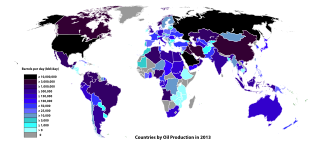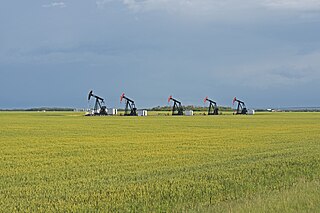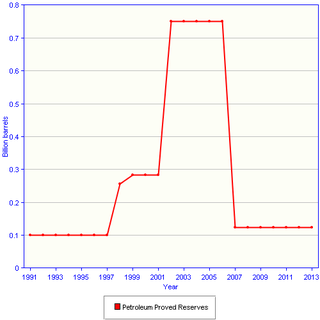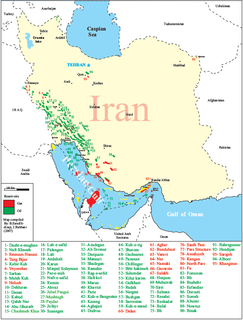 W
WThis is a list of countries by proven oil reserves. Proven reserves are those quantities of petroleum which, by analysis of geological and engineering data, can be estimated, with a high degree of confidence, to be commercially recoverable from a given date forward from known reservoirs and under current economic conditions.
 W
WThis article includes a chart representing proven reserves, production, consumption, exports and imports of oil by country.
 W
WOil reserves in Canada were estimated at 172 billion barrels as of the start of 2015 . This figure includes the oil sands reserves that are estimated by government regulators to be economically producible at current prices using current technology. According to this figure, Canada's reserves are third only to Venezuela and Saudi Arabia. Over 95% of these reserves are in the oil sands deposits in the province of Alberta. Alberta contains nearly all of Canada's oil sands and much of its conventional oil reserves. The balance is concentrated in several other provinces and territories. Saskatchewan and offshore areas of Newfoundland in particular have substantial oil production and reserves. Alberta has 39% of Canada's remaining conventional oil reserves, offshore Newfoundland 28% and Saskatchewan 27%, but if oil sands are included, Alberta's share is over 98%.
 W
WEstimates of total oil reserves in Cuba are varied, and depend mainly on estimations of undiscovered offshore deposits in the North Cuba Basin. Proved crude oil reserves were 124 million barrels as of 2013.
 W
WThe petroleum industry of Ghana is regulated by the state-owned Ghana National Petroleum Corporation (GNPC) and administered by the state-owned Ghana Oil Company (GOIL).
 W
WProven oil reserves in Iran, according to its government, rank fourth largest in the world at approximately as of 2013, although it ranks third if Canadian reserves of unconventional oil are excluded. This is roughly 10% of the world's total proven petroleum reserves. At 2020 rates of production, Iran's oil reserves would last 145 years if no new oil was found.
 W
WOil reserves in Libya are the largest in Africa and among the ten largest globally with 46.4 billion barrels as of 2010. Oil production was 1.65 million barrels per day as of 2010, giving Libya 77 years of reserves at current production rates if no new reserves were to be found. Libya is considered a highly attractive oil area due to its low cost of oil production, low sulfur content, being classified as "sweet crude" and in its proximity to European markets. Libya's challenge is maintaining production at mature fields, while finding and developing new oil fields. Most of Libya remains under-explored as a result of past sanctions and disagreements with foreign oil companies.
 W
WThe proven oil reserves in Saudi Arabia are the reportedly 2nd largest in the world, estimated to be 268 billion barrels, including 2.5 Gbbl in the Saudi–Kuwaiti neutral zone. They are predominantly found in the Eastern Province. These reserves were apparently the largest in the world until Venezuela announced they had increased their proven reserves to 297 Gbbl in January 2011. The Saudi reserves are about one-fifth of the world's total conventional oil reserves. A large fraction of these reserves comes from a small number of very large oil fields, and past production amounts to 40% of the stated reserves.
 W
WProven oil reserves in the United States were 43.8 billion barrels of crude oil as of the end of 2018, excluding the Strategic Petroleum Reserve. The 2018 reserves represent the largest US proven reserves since 1972. The Energy Information Administration estimates US undiscovered, technically recoverable oil resources to be an additional 198 billion barrels.
 W
WThe proven oil reserves in Venezuela are recognized as the largest in the world, totaling 300 billion barrels (4.8×1010 m3) as of 1 January 2014. The 2019 edition of the BP Statistical Review of World Energy reports the total proved reserves of 303.3 billion barrels for Venezuela (slightly more than Saudi Arabia's 297.7 billion barrels).